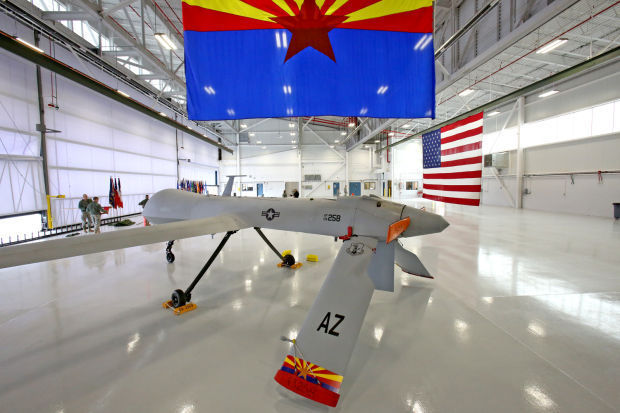SIERRA VISTA — After remotely flying unmanned aircraft over Iraq and Afghanistan for years, Arizona’s Air National Guard drone pilots can finally take off and land close to home.
On Thursday, the Arizona Air National Guard 214th Reconnaissance Group christened a new hangar and support facility at Fort Huachuca’s Libby Army Airfield that eventually will be home to four MQ-1 Predator drones for crew training and, eventually, stateside missions.
The ceremony, attended by Arizona Sens. John McCain and Jeff Flake, marked the opening of the $11 million hangar as home of the 214th’s Launch and Recovery Element.
The launch and recovery unit — which handles drone takeoffs and landings — is one of five such sites in the nation. With the new hangar, the 214th will help train airmen from across the country and is expected to fly homeland-security missions as needed in the future.
The 214th is part of the Air Guard 162nd Wing, based at Tucson International Airport. But the drone unit is physically based at Davis-Monthan Air Force Base, and the flying operation is based at Libby because of the access to military airspace there.
The reconnaissance unit began remotely flying drone missions from D-M in 2006. The 214th was placed under the 162nd Wing in April — prompting the wing to drop the word “fighter” from its name to reflect its new multirole mission. The 214th, which comprises some 180 crew members, has provided more than 70,000 hours of intelligence, surveillance and reconnaissance data to operations overseas.
While Predators and other U.S. military drones can be remotely controlled via satellite from anywhere, launch and landing duties are typically handled from forward bases.
The main mission of the Arizona Air Guard launch and recovery unit will be to support formal training of pilots and sensor operators, but that will likely evolve into providing direct support to civil authorities, 162nd Wing spokeswoman Lt. Lacey Roberts said.
Military officials have said that military drones may be used stateside for missions such as search and rescue and border surveillance.
In early November, the 214th flew its first launch-and-recovery mission from Libby even before the 22,500-square-foot hangar was completed.
During the hourlong flight, the Predator flawlessly performed a series of low approaches and touch-and-go maneuvers, officials said.
Col. Phil Purcell, commander of the Air Guard 162nd Wing, said after the inaugural flight that “Arizona remains at the forefront of readiness for any federal or state requirement.”
The new hangar is big enough to house four MQ-1 Predators or four somewhat larger MQ-9 Reaper drones, along with crew and maintenance workers, the Air Guard said. Pilots control the aircraft from ground-control stations in mobile trailers adjacent to the hangar.
Under a long-term force restructuring plan issued by the Air Force earlier this year, three MQ-1 Predators in Arizona would be replaced by the larger and more capable MQ-9 Reapers by fiscal year 2017.
The first Arizona-based Predator, parked in its hangar on Thursday, is the first military drone to sport Arizona livery, including an “AZ” and a state-flag “flash,” or identifying wingtip, on its downswept elevators.
It is also likely the first to sport a saguaro cactus — as part of the 162nd Wing emblem emblazoned on its fuselage.





